Maritime Satellite Communications Market Size
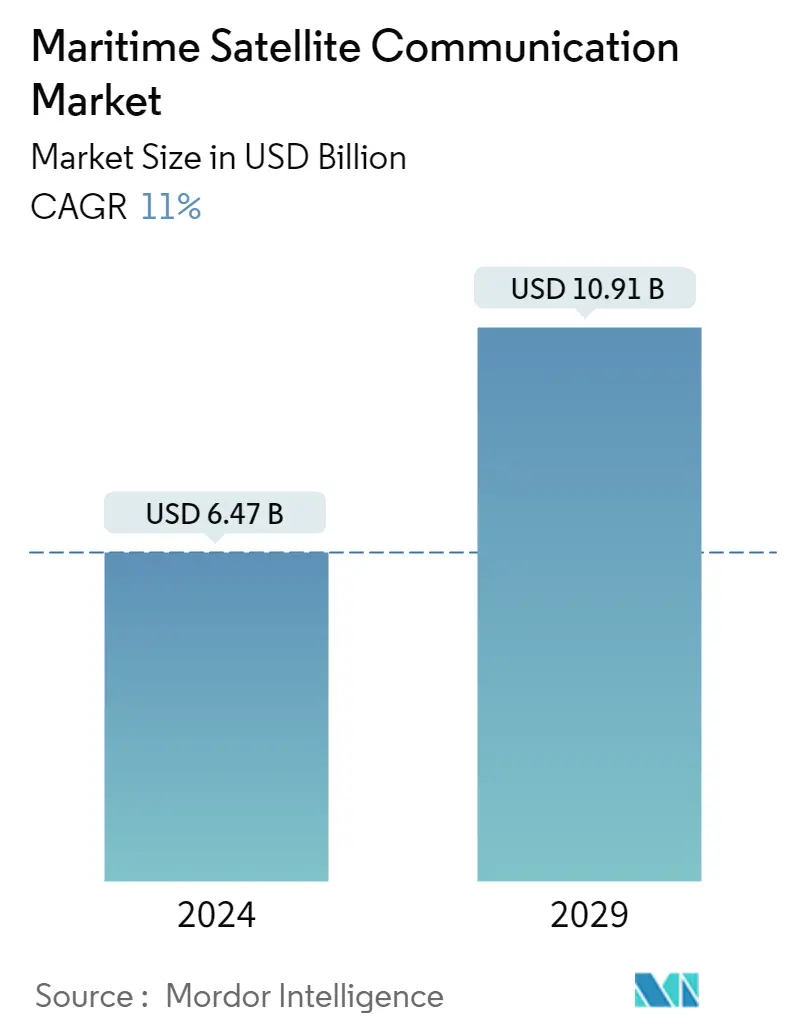
| Study Period | 2019 - 2029 |
| Market Size (2024) | USD 6.47 Billion |
| Market Size (2029) | USD 10.91 Billion |
| CAGR (2024 - 2029) | 11.00 % |
| Fastest Growing Market | Asia-Pacific |
| Largest Market | North America |
Major Players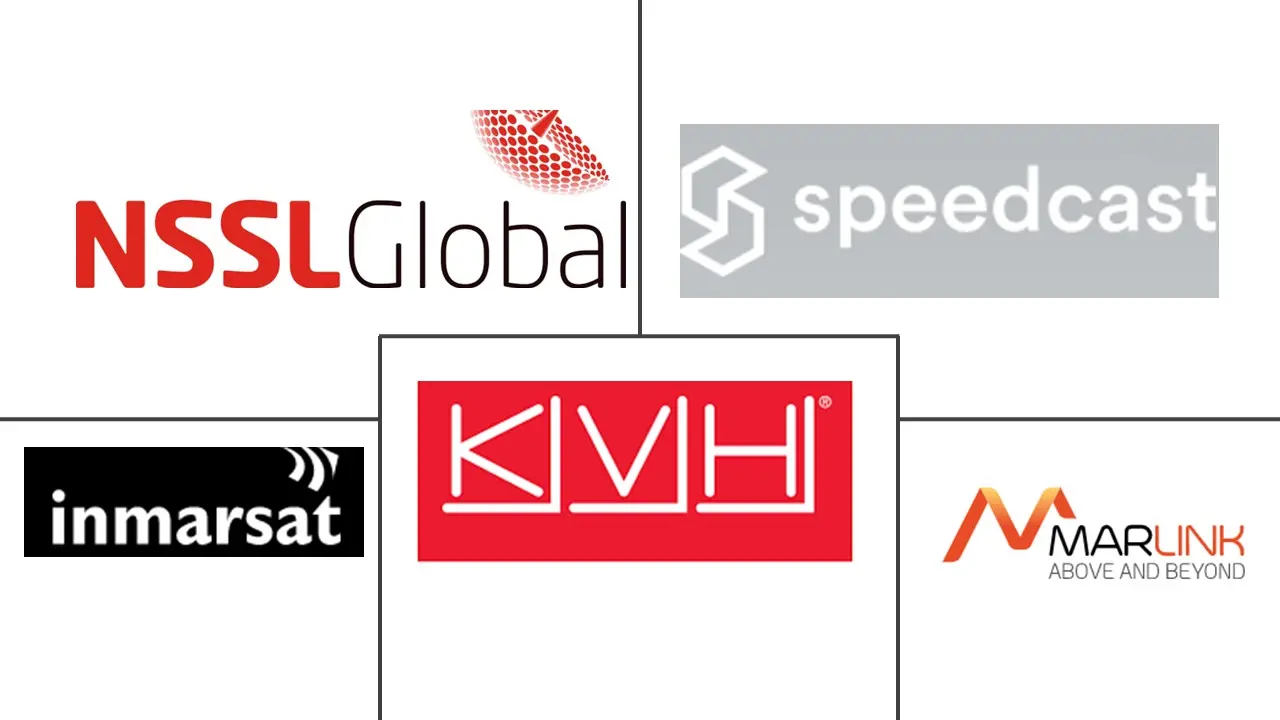
*Disclaimer: Major Players sorted in no particular order |
Need a report that reflects how COVID-19 has impacted this market and its growth?
Maritime Satellite Communication Market Analysis
The Maritime Satellite Communication Market size is estimated at USD 6.47 billion in 2024, and is expected to reach USD 10.91 billion by 2029, growing at a CAGR of 11% during the forecast period (2024-2029).
The primary market growth drivers include rising demand for broadband connections, VSAT connectivity, and high-throughput satellites to enable cloud and IoT applications. According to the Department of Telecommunications (India), in 2023, the total number of internet connections in India reached close to 851 million. The connectivity has almost tripled in the past few years, compared to 302.33 million connections.
- The ability to track cargo and ships worldwide is made possible by satellite communication systems. VSAT terminals are communication instruments that enable text, audio, and video data transmission and reception over satellite-based broadband internet assistance. These terminals are geostationary satellites on the Ku, Ka, and C bands. Service providers would require even greater capacity, performance, coverage, and flexibility to meet the maritime industry's changing needs, where end users have a wide range of communication needs. Furthermore, Service providers must be able to expand networks to meet consumer demands swiftly. Customers need help using satellite solutions due to the growing use of maritime satellite technologies.
- The rising demand for applications such as audio broadcasting and voice communications in end-user industries is projected to propel the growth of the satellite communication industry. For instance, in March 2023, Tata Communications launched a new cloud-based application, Jamvee, with integrated voice calling and messaging capabilities for enterprises. With flexible plans for voice calling and data roaming, Jamvee is a cost-efficient solution for the employee collaboration needs of enterprises.
- Crew welfare is made possible by digitalization's quick connectivity for VoIP conversations, messengers, and video conferencing. Smaller ships typically need more room or space for an expensive satellite communications setup, while large ships are quickly adopting new digitalization methods by VSAT communications. Orion Edge V provides a VSAT-like experience on little hardware for all vessels and allows for optimized applications through the OneGate platform for video conferencing, telemedicine, remote maintenance, and IoT. The Thuraya MarineStar terminal, which provides voice services like a public phone, and the Thuraya Orion IP broadband terminal, which offers data services, can be used as a primary communication system for small vessels.
- In May 2023, Viasat Inc., a global communications company, celebrated the successful launch of its ViaSat-3 Americas satellite. The satellite was launched aboard a SpaceX Falcon Heavy from Launch Complex 39A (LC-39A) at NASA’s Kennedy Space Center in Florida. Just 15 minutes after liftoff, the first signals from the satellite were acquired through a ground station in South Korea. Such developments in various regions may further propel the market's growth.
- Furthermore, the growing number of IoT-connected and sensing devices, such as autonomous shipping, performance computing, fleet management, and cybersecurity applications, is driving the demand for satellite communication. For instance, in November 2023, leading the charge in satellite communications, Viasat Inc. teamed up with Skylo Technologies, a prominent non-terrestrial network (NTN) service provider, to introduce the world's inaugural global direct-to-device (D2D) network. This groundbreaking move, facilitated by a global infrastructure agreement between the two companies, marks a significant milestone. It will empower mobile network operators (MNOs), device manufacturers, and chipset makers to bring 3GPP Release 17 compliant products to market, leveraging Viasat's extensive global network coverage.
- Companies also adopt voice-based mobile satellite services to connect employees with their families and close friends. For instance, Inmarsat offers a service called ChatCard, which assists in reducing feelings of isolation at sea by providing crewmembers the freedom to stay in touch with relatives and friends anywhere. The American communications firm Viasat Inc. is headquartered in Carlsbad, California, and has other domestic and abroad operations. Viasat provides secure networking solutions and high-speed satellite broadband services for the military and commercial markets. In the fiscal year 2023, the corporation made USD 1,210.7 million from the satellite services segment in revenue. Viasat's revenue has been steadily increasing.
- However, a lack of awareness about advanced maritime satellite services and the reliance on high-cost satellite equipment are hampering the market’s growth. Furthermore, high-throughput satellites to unlock cloud and IoT services and the unification of satellites and cellular communication technology will likely provide lucrative development opportunities for maritime satellite communication demand in the coming years.
- Moreover, inflation significantly impacts the market studied, as it can lead to higher costs for satellite communication industries. This can be due to various factors, such as higher prices for raw materials, increased shipping costs, and labor costs and shortages. As a result, manufacturers may be forced to raise their prices to maintain profitability, ultimately decreasing the demand.
Maritime Satellite Communication Market Trends
Maritime Satellite Communication Service Offering to Hold Significant Market Share
- The growing ecosystem of maritime transportation and its benefits with the circular economy, such as decreasing carbon footprints and other aspects, coincide with the organizational goals of the companies and demands for data-driven maritime services. These are best bolstered with the satellite communication providers offering services for busy vessel routes.
- The increasing traffic on specific routes creates a considerable requirement for maritime satellite communication services for multiple shipping and maritime service providers. According to the Ministry of Ports, Shipping, and Waterways (India), the volume of sea cargo traffic handled at the ports of the Indian state of Gujarat was over 500 million metric tons.
- Such high demands and handling of shipping across the ports invite maritime communication service providers to offer their reliable services for efficient and responsive satellite communication to track the shipments correctly and accurately, ensuring safe delivery of the shipments. In January 2024, Singtel, a prominent player in the maritime connectivity space, integrated Starlink's cutting-edge low-earth orbit (LEO) satellite broadband service into its offerings. This strategic move is poised to catalyze the adoption of digital solutions among ship owners and telecom operators. By leveraging this technology, they aim to innovate and harness advanced tools like artificial intelligence (AI), 5G, edge computing, and cloud-based solutions.
- Similarly, across the maritime industry in many different sectors, key players are working on advancements to provide reliable satellite communication services to their shipping counterparts. For instance, Tototheo Maritime is a prominent player in communication and maritime tech services. The company’s latest move, announced in January 2024, involves bolstering its suite of fixed and mobile connectivity solutions. These solutions are meticulously crafted to safeguard their clients' operations, ensuring seamless business continuity even in challenging scenarios. This strategic pivot underscores Tototheo Maritime's dedication to fortifying and enabling its clients' business endeavors with the latest communication tech.
- In different parts of the world, established wireless satellite communication service providers, including private players, are also entering the maritime communication spectrum through gradual advancements, providing profound connectivity to maritime customers. Such developments help build the ecosystem to bridge the gap between maritime satellite communication and the terrestrial bounds.
- For instance, in October 2023, OneWeb, the international low Earth orbit (LEO) communications network, announced its latest offering for the maritime industry, the "Try Before You Buy" maritime service. This service entitles maritime users to experience OneWeb's enterprise-grade flexible connectivity packages at sea, providing high-speed connectivity of over 100 Mbps. With 634 satellites in orbit, the OneWeb constellation is now complete and entirely operational down to 35 degrees latitude.
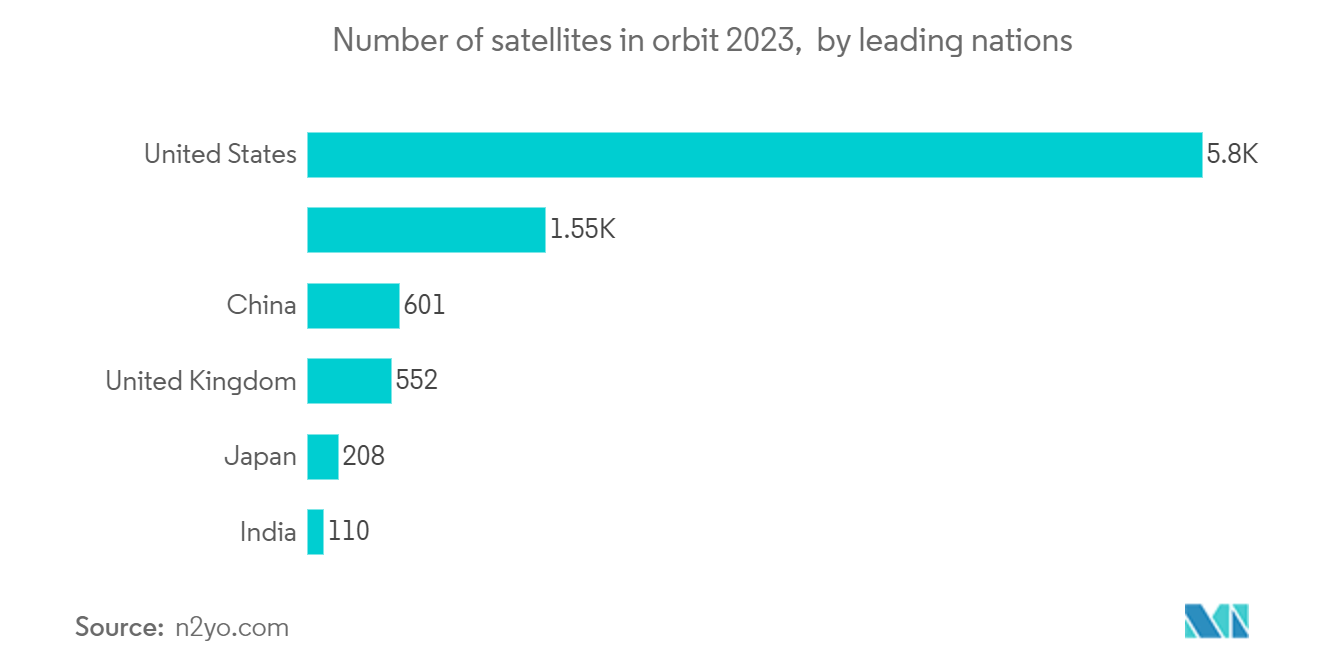
Asia-Pacific to Witness Significant Market Growth
- Due to the rising use of waterways for transportation, the increasing government initiatives, and the expanding use of satellite communication, the Asia-Pacific region (predominantly in India, China, Japan, Malaysia, and Singapore) is anticipated to be the fastest-growing segment in the maritime analytics market. In addition, the region's abundance of significant solution and service companies may foster market progress in Asia-Pacific.
- In May 2024, KT SAT, South Korea's leading satellite communications provider, and Rivada Space Networks inked an MoU. Their collaboration aims to revolutionize connectivity for both enterprise and government clients, with a particular focus on expanding their reach in the Asia-Pacific region and beyond. The envisioned 'outernet' holds immense promise for these clients. It can bolster security for banks and multinational corporations with dispersed offices, offer enhanced bandwidth for oil and gas exploration, ensure seamless connectivity for shipping and fleet management, and even facilitate the expansion of 5G satellite backhaul networks for cellular operators.
- According to the Broadband India Forum, the new standard for Interface Requirements for Communication & Broadcast Networks for fixed-satellite service-FSS/broadcasting satellite service-BSS (mandatory technical requirements) may authorize the ground segment very-small-aperture terminal (VSAT) participants to take advantage of the latest SATCOM technologies (BIF).
- As per the Ministry of Ports, India's major ports handled 819.3 of total cargo in FY 2023-2024. According to IBEF, approximately 95% of India's merchandise trade is done through seaports. The country is one of the most significant peninsulas in the world, with a coastline of 7,516.6 km and 200 major and non-major ports. Hence, the rising number of ports in the region is creating a requirement for monitoring shipping-related activities, which may fuel the growth of the Asia-Pacific satellite communication market.
- In May 2024, Cobham Satcom unveiled its latest offerings, the SAILOR XTR 100 TVRO and SAILOR XTR 120 TVRO antennas. With Cobham Satcom's extensive experience in the Sea Tel TVRO line and incorporating advanced technology from the SAILOR XTR VSAT platform, these antennas promise heightened performance and expanded capabilities. They are designed to cater to a broad spectrum of vessels, ranging from superyachts and cruise ships to merchant vessels.
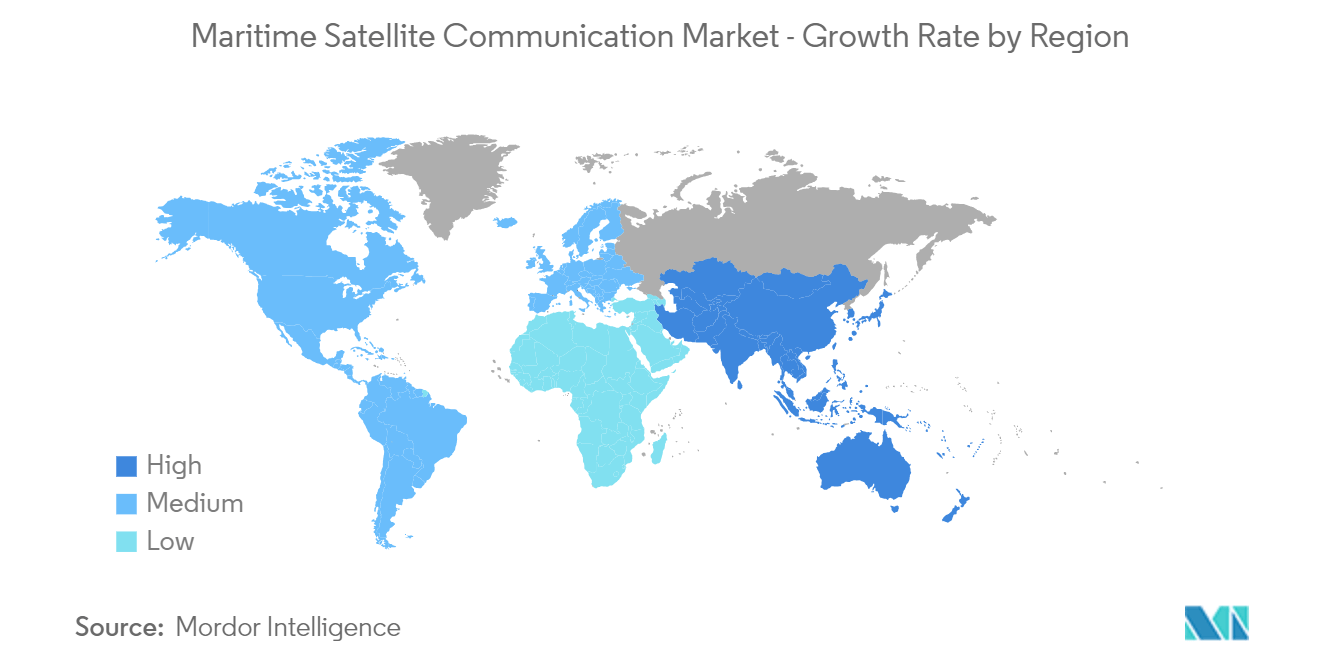
Maritime Satellite Communication Industry Overview
The maritime satellite communication market is favorably competitive with several players. In terms of market share, few of the major players currently dominate the market. These major players, with a prominent market share, focus on developing their customer base across foreign countries. These corporations leverage strategic collective initiatives to increase their market share and profitability.
- April 2024: Unseenlabs, a French maritime surveillance company known for its expertise in radio frequency (RF) detection, is set to bolster its fleet. In 2026, the company plans to broaden its scope, moving beyond maritime surveillance to monitor both terrestrial and space environments. This expansion will be facilitated by Unseenlabs' innovative "monosatellite" technology, allowing the company to extend its surveillance capabilities across the seas, land, and space.
- January 2024: In a historic move, India's ISRO is set to deploy its 4.7-tonne GSAT-20 communications satellite, utilizing SpaceX's Falcon-9 rocket. GSAT-20's mission is to bolster India's broadband capabilities, elevate in-flight and maritime communications, and fortify cellular backhaul services.
Maritime Satellite Communication Market Leaders
-
Inmarsat Group Limited
-
Marlink SAS (Providence Equity Partners)
-
KVH Industries Inc.
-
Speedcast
-
NSSL Global Limited
*Disclaimer: Major Players sorted in no particular order
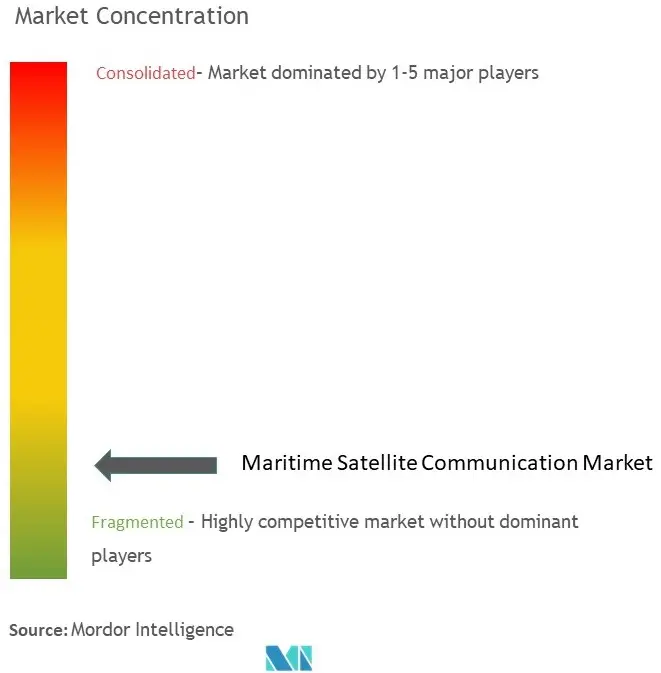
Maritime Satellite Communication Market News
- May 2024: Inmarsat Maritime, a Viasat company, introduced NexusWave, a comprehensive connectivity service. NexusWave utilizes a 'bonded' multi-dimensional network to provide high-speed connectivity, unlimited data, global coverage, and a robust 'secure by design' infrastructure. As a fully managed service from a single provider, NexusWave integrates multiple high-speed networks in real time. These include Global Xpress (GX) Ka-band, low-Earth orbit (LEO) services, and coastal LTE, with an additional L-band layer for enhanced resiliency. This combination ensures fast, always-on connectivity. NexusWave features an enterprise-grade firewall, a security measure trusted by global enterprises and governments.
- April 2023: A collaborative effort between the Satellite Technology and Research Center (STAR) at the National University of Singapore's College of Design and Engineering (NUS CDE) and A*STAR's I2R has resulted in the successful launch of an advanced microsatellite for maritime communications from the Satish Dhawan Space Center in Sriharikotta, India.
Maritime Satellite Communications Market Report - Table of Contents
1. INTRODUCTION
1.1 Study Assumptions and Market Definitions
1.2 Scope of the Study
2. RESEARCH METHODOLOGY
3. EXECUTIVE SUMMARY
4. MARKET INSIGHTS
4.1 Market Overview
4.2 Industry Attractiveness - Porter's Five Forces Analysis
4.2.1 Threat of New Entrants
4.2.2 Bargaining Power of Buyers
4.2.3 Bargaining Power of Suppliers
4.2.4 Threat of Substitute Products and Services
4.2.5 Intensity of Competitive Rivalry
4.3 Technology Snapshot (Ka, Ku, and C Bands, Size of Terminals, Application Notes, and Penetration)
4.4 Impact of Macroeconomic Trends on Maritime VSAT and Allied Markets
5. MARKET DYNAMICS
5.1 Market Drivers
5.1.1 Increasing Need for Connectivity for Crew Welfare and Operations
5.1.2 Launch of High-Throughput Satellite (HTS) Satellites
5.2 Market Restraints
5.2.1 Lack of Awareness About the Advanced Satellite Service Market
5.2.2 Reliance on High-cost Satellite Equipment
6. MARKET SEGMENTATION
6.1 By Type
6.1.1 Mobile Satellite Communication or Mobile Satellite Services (MSS)
6.1.2 Very Small Aperture Terminal (VSAT)
6.2 By Offering
6.2.1 Solution
6.2.2 Service
6.3 By End-User Vertical
6.3.1 Merchant (Cargo, Tanker, Container, Bulk Carrier, etc.)
6.3.2 Offshore Rigs and Support Vessels
6.3.3 Passenger Fleet (Cruise and Ferry)
6.3.4 Leisure (Yachts)
6.3.5 Finishing Vessels
6.4 By Geography
6.4.1 North America
6.4.2 Europe
6.4.3 Asia-Pacific
6.4.4 Rest of the World
7. COMPETITIVE LANDSCAPE
7.1 Company Profiles*
7.1.1 Inmarsat Group Limited
7.1.2 Marlink SAS (Providence Equity Partners)
7.1.3 KVH Industries Inc.
7.1.4 Speedcast International
7.1.5 NSSL Global Limited
7.1.6 Cobham Satcom
7.1.7 Iridium Communications Inc.
7.1.8 Thuraya Telecommunications Company
7.1.9 Hughes Network Systems LLC
7.1.10 Viasat Inc.
8. INVESTMENT ANALYSIS
9. FUTURE OF THE MARKET
Maritime Satellite Communication Industry Segmentation
Marine communication involves ship-to-ship and ship-to-shore communication. Over the years, how seamen communicate has changed drastically. Previously, semaphores and flags were a primary form of communication for ships out at sea. Maritime satellite communication comprises a range of communication service offerings delivered mainly through Ku-band, L-band, and Ka-band frequency-based satellite communication services, which help communication worldwide.
The market is segmented by types, such as mobile satellite communication or mobile satellite services (MSS) and very small aperture terminal (VSAT), among solution and service offerings. The study also comprises various end-user verticals such as merchant, (cargo, tanker, container, bulk carrier), offshore rigs and support vessels, passenger fleet (cruise and ferry), leisure (yachts), and finishing vessels in multiple geographies such as North America, Europe, Asia-Pacific, and Rest Of The World. The impact of macroeconomic trends on the market is also covered under the scope of the study. The disturbance of the factors affecting the market's evolution in the near future are also covered as drivers and constraints. The market sizes and forecasts are provided in terms of value (USD) for all the above segments.
| By Type | |
| Mobile Satellite Communication or Mobile Satellite Services (MSS) | |
| Very Small Aperture Terminal (VSAT) |
| By Offering | |
| Solution | |
| Service |
| By End-User Vertical | |
| Merchant (Cargo, Tanker, Container, Bulk Carrier, etc.) | |
| Offshore Rigs and Support Vessels | |
| Passenger Fleet (Cruise and Ferry) | |
| Leisure (Yachts) | |
| Finishing Vessels |
| By Geography | |
| North America | |
| Europe | |
| Asia-Pacific | |
| Rest of the World |
Maritime Satellite Communications Market Research FAQs
How big is the Maritime Satellite Communication Market?
The Maritime Satellite Communication Market size is expected to reach USD 6.47 billion in 2024 and grow at a CAGR of 11% to reach USD 10.91 billion by 2029.
What is the current Maritime Satellite Communication Market size?
In 2024, the Maritime Satellite Communication Market size is expected to reach USD 6.47 billion.
Who are the key players in Maritime Satellite Communication Market?
Inmarsat Group Limited, Marlink SAS (Providence Equity Partners), KVH Industries Inc., Speedcast and NSSL Global Limited are the major companies operating in the Maritime Satellite Communication Market.
Which is the fastest growing region in Maritime Satellite Communication Market?
Asia-Pacific is estimated to grow at the highest CAGR over the forecast period (2024-2029).
Which region has the biggest share in Maritime Satellite Communication Market?
In 2024, the North America accounts for the largest market share in Maritime Satellite Communication Market.
What years does this Maritime Satellite Communication Market cover, and what was the market size in 2023?
In 2023, the Maritime Satellite Communication Market size was estimated at USD 5.76 billion. The report covers the Maritime Satellite Communication Market historical market size for years: 2019, 2020, 2021, 2022 and 2023. The report also forecasts the Maritime Satellite Communication Market size for years: 2024, 2025, 2026, 2027, 2028 and 2029.
Maritime Satellite Communications Industry Report
Statistics for the 2023 Maritime Satellite Communications market share, size and revenue growth rate, created by Mordor Intelligence™ Industry Reports. Maritime Satellite Communications analysis includes a market forecast outlook to 2029 and historical overview. Get a sample of this industry analysis as a free report PDF download.

